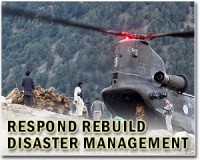| . |  |
. |
Manila (AFP) Sept 25, 2010 One year after tropical storm Ketsana brought death and destruction to Manila, the Philippines remains unprepared for such disasters, the government said on Saturday. Lack of funds has prevented officials from taking all measures necessary to minimise the risk from weather systems such as Ketsana, which flooded the capital and left over 400 people dead, disaster monitoring chief Benito Ramos said. Nor is there enough money to relocate thousands of families still living in ramshackle or precarious conditions susceptible to -- and exacerbating -- flooding during the current typhoon season, said Ramos. At the start of the wet season in June the government estimated there were at least 2.7 million squatters in Manila, including about half a million living in dangerous areas such as beneath bridges, atop open sewers, swamps and riverbanks. Experts blamed the massive flooding partly on clogged drains and waterways but the government has largely failed to remove the thousands of squatters whose shanties obstruct the waterways. Tropical storm Ketsana took many by surprise on September 26, 2009 when it unleashed heavy rains that caused the worst flooding in Manila in four decades. Even residents of plush, gated communities were forced to take refuge on the roofs of their houses as the water rose and large parts of Manila and surrounding areas stayed flooded for months afterwards. Typhoon Parma struck the country's north a week later, unleashing more floods and landslides that brought the combined death toll, including diseases induced by the floods, to more than 1,000. The World Bank put the combined rehabilitation and recovery costs at about 4.4 billion dollars. In a statement to mark the weekend anniversary of the Ketsana flooding, Ramos said the national government did not have enough funds to prepare for the 20 or so storms that hit the impoverished Philippines every year. He urged local governments to help out by boosting early warning systems and taking charge in evacuating residents before an anticipated deluge. Clogged rivers, waterways and drainage systems needed to be regularly dredged, while relief goods must be stockpiled and rescue equipment pre-positioned near where they are expected to be needed, he added. He also said local officials should be more alert as climate change could make disasters like typhoons more destructive. Defence Secretary Voltaire Gazmin, who is also in charge of civil defence, said in an interview with GMA television that while the government was boosting its rescue capabilities, it could still fall short. "Our government's resources are adequate to respond to the minimum requirements, but owing to the unpredictability of nature, there might not be enough to provide relief within the first few hours of any tragedy," he said. The anniversary of the deadly storm is being commemorated in various ways with government agencies conducting rescue drills, volunteers cleaning garbage out of waterways and people lighting lanterns in honour of the deceased. The Philippines is one of the most disaster-prone countries in the world, the Brussels-based Centre for Research on the Epidemiology of Disasters think-tank said. Tropical storms, floods, landslides, and maritime disasters killed nearly 2,000 people across the Philippines in 2009, the government said.
Share This Article With Planet Earth
Related Links Bringing Order To A World Of Disasters A world of storm and tempest When the Earth Quakes
 More help sought for UN peacekeepers
More help sought for UN peacekeepersUnited Nations (AFP) Sept 23, 2010 The UN Security Council on Thursday demanded extra resources for peacekeepers at a special meeting where ministers said UN troops were unfairly risking their lives. With some missions facing criticism for their actions, the Council issued a statement calling for "adequate resourcing" and strong military and civilian leadership. The council also highlighted the new international security ... read more |
|
| The content herein, unless otherwise known to be public domain, are Copyright 1995-2010 - SpaceDaily. AFP and UPI Wire Stories are copyright Agence France-Presse and United Press International. ESA Portal Reports are copyright European Space Agency. All NASA sourced material is public domain. Additional copyrights may apply in whole or part to other bona fide parties. Advertising does not imply endorsement,agreement or approval of any opinions, statements or information provided by SpaceDaily on any Web page published or hosted by SpaceDaily. Privacy Statement |